Lea Wait's Blog, page 4
October 7, 2025
We’re Dying to Have You Join Us
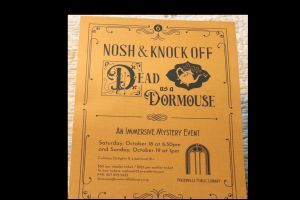
John Clark inviting you to join us on Sunday, October 19th at 1 PM (the Saturday Night show is already sold out.) What are we inviting you to? Nosh & Knock Off 2025, an immersive mystery event. This year’s play is called Dead As A Doormouse.
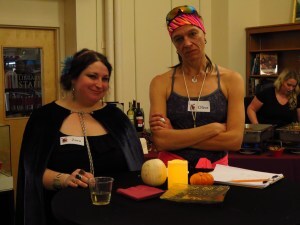
You shouldda kept quiet!
Nosh and Knock Off began some ten years ago as a combined acting opportunity for local talent in the Waterville area, and fundraiser for the Waterville Public Library. COVID-19 sent it on hiatus until last fall. As a member of the library board, I got involved in fundraising from local businesses and then setting up the day of the show. Little did I know how much fan Beth and I would have.
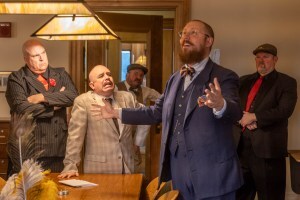
I couldn’t keep quiet!
The play takes place in the library, complete with culinary delights and libations for those 21+. We’re adding a 50/50 raffle this year. Those in attendance are right in the middle of a mystery with actors seemingly coming out of the crowd unexpectedly. Everyone is encouraged to figure out who the killer might be.

Who Dunnit?
Last year the library was turned into a speakeasy with the victim dying while giving a speech at the very beginning of the play. You could tell everyone in attendance was really getting into it. I expect the same will be the case this year. I am looking forward to having another fun evening while putting my sleuthing skills to work. Sunday tickets are $50 and can be purchased at wplnosh25.eventbrite.com
Hope to see some blog readers join us.
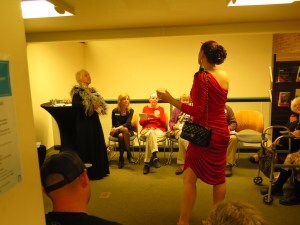
October 5, 2025
How Lucky We Are
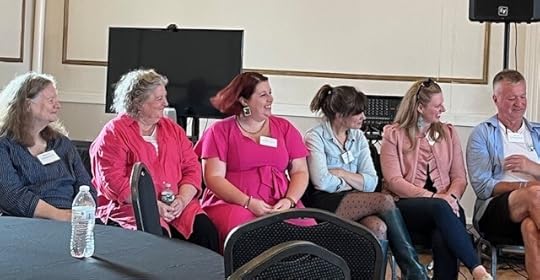
Barbara Ross, Jule Selbo, Nicole Asselin, Gabi Stiteler, Jules O’Brien and Matt Cost engaged in a round of “Ask Me Anything” at the Maine Crime Wave.
Since the Crime Wave rolled through Maine last week, I’ve thought a lot about how fortunate we are to have this amazing crime writing community.
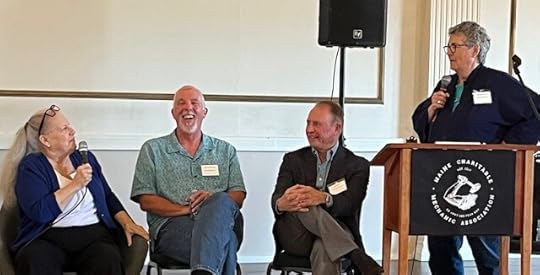
Julie Spencer-Fleming, Bruce Coffin, Paul Doiron and me during “Ask Me Anything.”
Events like the Wave bring us together to talk and laugh, read and commiserate. Writers from other places are amazed by the degree of friendship and support we share. It’s a bond to be celebrated.
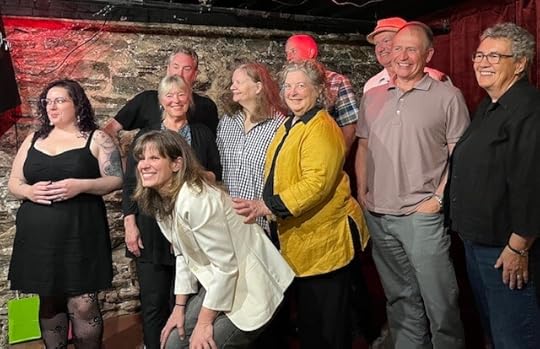
The readers at Noir @ The Bar, from left, Katie York, Kate Flora, Chris Holm, Barbara Ross, Jule Selbo, Bruce Coffin, Matt Cost, Paul Doiron and me, with Gabi Stiteler, who was the moving force behind organizing the Friday night event, in front.
This year, Friday night featured readings at a Noir @ The Bar held at the Congress Street venue Novel.
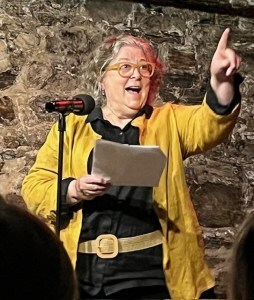
Jule Selbo
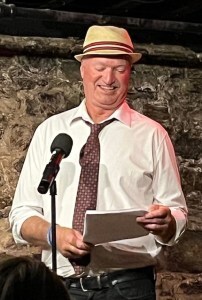
Matt Cost
With Jule Selbo and Matt Cost acting as emcees, a packed house heard nine Maine crime writers read five-minute passages from their work. In between the readings there were trivia questions (with fabulous prizes) and plenty of schmoozing in the audience.
It was the perfect first course for the weekend feast of everything crime writing. In a break with convention, the Crime Wave organizing committee decided this year to move away from panel discussions in favor of roundtable discussions on various topics.
This resulted in active, enthusiastic interaction at every stage of the conference, from informal chats in the library at Mechanic’s Hall to substantive discussions about craft and the writing biz.
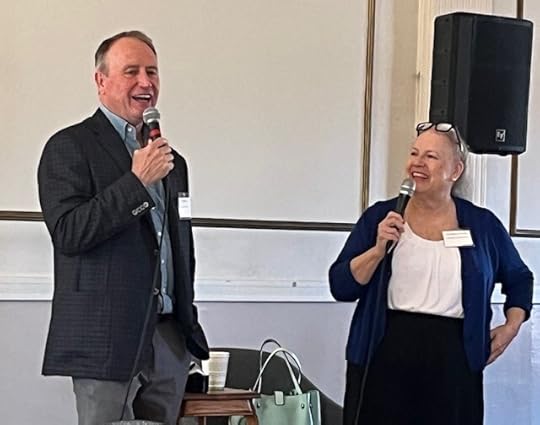
The lunchtime interview featured two of Maine’s most well-known crime writers, Julia Spencer-Fleming’s and Paul Doiron.
As the day’s Guest of Honor, Paul Doiron was interviewed during the lunch hour by Julia Spencer-Fleming. Their talk about finding one’s way as a writer was leavened with humor and warmth.
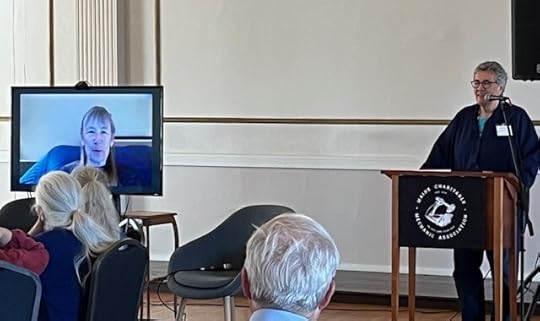
Mary Squibb, a/k/a Sarah Graves, joined us remotely from her home in Eastport to accept the Lea Wait Award.
Mary Squibb, known to her legions of readers as Sarah Graves, writer of the Home Repair is Homicide series, the Lizzie Snow series and the current Death by Chocolate series, was the gracious recipient of the annual award that honors our late sister Lea Wait, who may be gone but will never be forgotten.
A mega panel at the end of the day gathered a dozen writers for a round of “Ask Me Anything,” where everyone razzed Paul Doiron and Matt Cost admitted that if he could be any other writer on the panel, he’d be Chris Holm, and provided specific and hilarious reasons why.
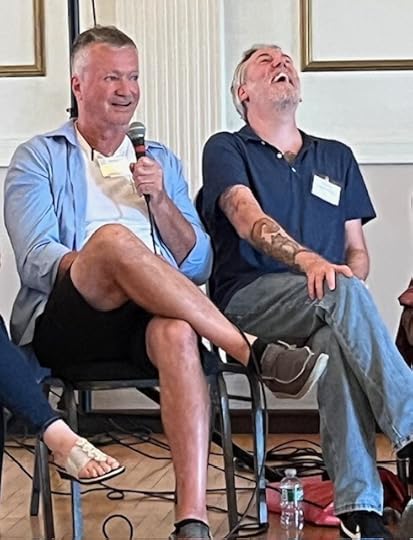
Matt Cost confessing he dreams of being Chris Holm.
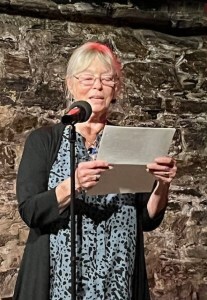
Kate Flora, one of the most consistent forces who has nurtured the Maine crime writing community.
This community was built over the years by many people and institutions.
This blog, which Kate Flora and Kathy Lynn Emerson founded oh so many years ago, is a big part of that. The Maine Writers and Publishers Alliance, which sponsors Crime Wave, is another.
Of course our crime writing community grows out of the rich literary world here in Maine, and thanks are owed to MWPA, its director Gibson Fay-LeBlanc and the rest of the staff, for appreciating and backing the need for an annual gathering of the crime writer tribe.
(Credit for all of the photos to Diane Kenty!)
Brenda Buchanan sets her novels in and around Portland. Her three-book Joe Gale series features a contemporary newspaper reporter with old-school style who covers the courts and crime beat at the fictional Portland Daily Chronicle. Brenda’s short story, Means, Motive, and Opportunity, was in the anthology Bloodroot: Best New England Crime Stories 2021 and received an honorable mention in Best American Mystery and Suspense 2022. Her story Assumptions Can Get You Killed appeared in Wolfsbane: Best New England Crime Stories 2023. A new short story, Cape Jewell, will be published in November in Snakeberry: Best New England Crime Stories 2025.
October 3, 2025
Weekend Update: October 4-5, 2025
 Next week at Maine Crime Writers there will be posts by Brenda Buchanan (Monday). John Clark (Tuesday), Jule Selbo (Thursday), and Joe Souza (Friday).
Next week at Maine Crime Writers there will be posts by Brenda Buchanan (Monday). John Clark (Tuesday), Jule Selbo (Thursday), and Joe Souza (Friday).
In the news department, here’s what’s happening with some of us who blog regularly at Maine Crime Writers:
Matt Cost had a fabulous time at Noir at Novel in Portland and Maine Crime Wave Roundtables this past weekend. Coming up next week, he will be going a COST TALK about The Not So Merry Adventures of Max Creed at the Jesup Memorial Library in Bar Harbor on Thursday at 6:30 PM.
Kate Flora: Sunday from 1-3 I will be at Books a Million in South Portland. Come by and say hello.
An invitation to readers of this blog: Do you have news relating to Maine, Crime, or Writing? We’d love to hear from you. Just comment below to share.
And a reminder: If your library, school, or organization is looking for a speaker, we are often available to talk about the writing process, research, where we get our ideas, and other mysteries of the business, along with the very popular “Making a Mystery” with audience participation, and “Casting Call: How We Staff Our Mysteries.” We also do programs on Zoom. Contact Kate Flora
Exploring the Language of Fall
 Kate Flora: Sometimes to create a mood, sometimes looking for a theme for a character, and sometimes searching for the perfect epigraph for a chapter, I dive into one of the many books of poetry on my shelves. Often at the end of the exercise I will have four or five open books on the floor, along with my trust Rodale’s Synonym Finder. Today is such a day. The weather has been amazing, making it hard to stay inside and finish this darned book. There are bulbs to planted for spring, and there is something about fall that makes me want to cook stews and pot roast and bake a chicken and make apple desserts and a cake with Italian prune plums.
Kate Flora: Sometimes to create a mood, sometimes looking for a theme for a character, and sometimes searching for the perfect epigraph for a chapter, I dive into one of the many books of poetry on my shelves. Often at the end of the exercise I will have four or five open books on the floor, along with my trust Rodale’s Synonym Finder. Today is such a day. The weather has been amazing, making it hard to stay inside and finish this darned book. There are bulbs to planted for spring, and there is something about fall that makes me want to cook stews and pot roast and bake a chicken and make apple desserts and a cake with Italian prune plums.
I wonder: Does fall do this to you as well?
When I’m setting a scene in fall and it actually isn’t fall, I have to dive into autumnal language to help create the mood. Even when the book does take place in fall, setting the scene can be a challenge. What words capture the tension between seeing summer end and impending winter? What words capture that tension for an officer having to give up his plans on a gorgeous fall day to attend to a crime scene?
My third Joe Burgess procedural, Redemption, begins on a day Burgess describes this  way:
way:
The warm and windy October day was so beautiful it hurt. The sky and the dancing sea were a deep, sapphire blue, the trees in the city rising up behind them in the full glory of a Maine fall. Fishing boats tied to the dock creaked and groaned and the rigging on berthed sailboats clanged. Farther out, the water was dotted with white canvas as sailors squeezed in one last day before their boats got hauled and shrink-wrapped.
Despite the fishy smells permeating the old wharf, the air seemed nutritious and refreshing. It was a day made for hikes and picnics, for apple picking and seeking the perfect Halloween pumpkin. For breathing in the crisp fall air and being glad to be alive. For law enforcement, it would be a long, slow day for death.
Do you have a favorite fall poem? What about a favorite recipe?
Here are some fall poems I’ve found:
When You Are Old
William Butler Yeats
When you are old and grey and full of sleep,
And nodding by the fire, take down this book,
And slowly read, and dream of the soft look
Your eyes had once, and of their shadows deep;
How many loved your moments of glad grace,
And loved your beauty with love false or true,
But one man loved the pilgrim soul in you,
And loved the sorrows of your changing face;
And bending down beside the glowing bars,
Murmur, a little sadly, how Love fled
And paced upon the mountains overhead
And hid his face amid a crowd of stars.

Autumn
John Clare
I love the fitfull gusts that shakes
The casement all the day
And from the mossy elm tree takes
The faded leaf away
Twirling it by the window-pane
With thousand others down the lane
I love to see the shaking twig
Dance till the shut of eve
The sparrow on the cottage rig
Whose chirp would make believe
That spring was just now flirting by
In summers lap with flowers to lie
I love to see the cottage smoke
Curl upwards through the naked trees
The pigeons nestled round the coat
On dull November days like these
The cock upon the dung-hill crowing
The mill sails on the heath a-going
The feather from the ravens breast
Falls on the stubble lea
The acorns near the old crows nest
Fall pattering down the tree
The grunting pigs that wait for all
Scramble and hurry where they fall
Autumn Fires
Robert Louis Stevenson
In the other gardens
And all up in the vale,
From the autumn bonfires
See the smoke trail!
Pleasant summer over,
And all the summer flowers,
The red fire blazes,
The grey smoke towers.
Sing a song of seasons!
Something bright in all!
Flowers in the summer,
Fires in the fall!
Nothing Gold Can Stay
Robert Frost
Nature’s first green is gold,
Her hardest hue to hold.
Her early leaf’s a flower;
But only so an hour.
Then leaf subsides to leaf.
So Eden sank to grief,
So dawn goes down to day.
Nothing gold can stay.
We won’t be having fires to burn leaves this fall. Maine is in a state of severe drought. It’s a smell I will miss.

October 1, 2025
Recommended Reads, Series Edition
Kaitlyn Dunnett/Kathy Lynn Emerson here. As regular MCW readers know, I’m semi-retired. What you may not know is that since I no longer care to travel far from home and can no longer do jigsaw-puzzles because of arthritis in my fingers, my primary leisure time activity is reading. No surprise there, I suppose. I read the occasional new-to-me books, but the majority of my choices are actually novels I’ve already read at least once, and most of them are part of a series.
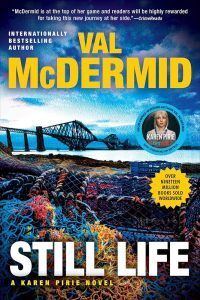 Today, lacking inspiration for anything more complex, I thought I’d share some of my favorites. With colder weather coming on, picture yourself reading a mystery series from the beginning or reading linked books in the romantic suspense genre while curled up in front of a warm fire with your pet-of-choice sharing a comfy chair.
Today, lacking inspiration for anything more complex, I thought I’d share some of my favorites. With colder weather coming on, picture yourself reading a mystery series from the beginning or reading linked books in the romantic suspense genre while curled up in front of a warm fire with your pet-of-choice sharing a comfy chair.
First up, a series that was new-to-me until BritBox decided to film the first one. Val McDermid is one of the queens of crime fiction writing and I’d read some of her single titles before, but when I started the Karen Piries I was instantly hooked. She’s the head of a cold cases unit of the Scottish police force. I’ve read all seven and am eagerly awaiting #8 in December. #6 (Still Life) and #7 (Past Lying) are my favorites so far—total page-turners.

original paperback cover
I’m currently working my way through two historical series re-reads. In mystery I’m enjoying my seventh reading of Elizabeth Peters’s Amelia Peabody books (archaeologists in Egypt in the late nineteenth century), starting with Crocodile on the Sandbank. Yes, seven, although a couple of those (since 1985) have been listening to the audio books rather than reading my tattered old paperbacks. I also have some titles in e-book format. I’m alternating that series with Mary Jo Putney’s excellent Lost Lords tales. These are stories of romantic suspense set in the Regency era and are packed with action and adventure. Lots of spies and treasonous plots to go with the love stories. The hero of each is a graduate of a school for aristocratic boys who were a bad fit for other institutions. Although each book has its focus on a different couple, the characters from earlier books reappear in each of the later ones. If romance novel love scenes aren’t your cup of tea, you can always skip them and enjoy the rest. The first is Loving a Lost Lord.
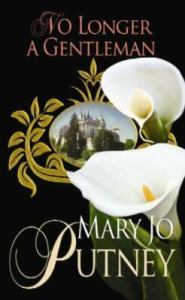
This is the one I’m rereading as I write this
And of course I can’t write about rereading series novels without mentioning that I spent a good part of the past year re-reading all 60 (yes, sixty) In Death novels by J. D. Robb (pseudonym for Nora Roberts). Set in the not-too-distant future in New York City, where Eve Dallas is a homicide detective, they are definitely not cozy. Again, mystery purists can skip the sex scenes, but it would be criminal not to give this series a try. The first is Naked in Death.
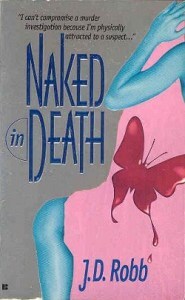
another original paperback cover
If you enjoy following characters through more than one book, all these series are worth a read. Other suggestions anyone? Feel free to comment.

Kathy Lynn Emerson/Kaitlyn Dunnett has had sixty-four books traditionally published and has self published others. She won the Agatha Award and was an Anthony and Macavity finalist for best mystery nonfiction of 2008 for How to Write Killer Historical Mysteries and was an Agatha Award finalist in 2015 in the best mystery short story category. In 2023 she won the Lea Wait Award for “excellence and achievement” from the Maine Writers and Publishers Alliance. She was the Malice Domestic Guest of Honor in 2014. She is currently working on creating new editions of her backlist titles. Her website is www.KathyLynnEmerson.com.
September 30, 2025
Fall in Maine
This month our group post is about fall in Maine. Whether it’s the brilliance of our leaves, the change in weather that tempts us out for fall walks, apple picking, or farmer’s markets, or its the shortening of the days, the changing light, and the gloom of impending winter, fall has an impact on all of us.
Kate Flora: I am always very much on the fence about fall. I love the cooler weather that tempts me out to take more walks. I love the bright bags of apples at the farmers market, the new varieties of squash to explore in my culinary activities, and the often dazzling fall sunsets. I don’t like the way it turns dark so early and the end of my plunges into the sea.
 When I reflect back on growing up on a Maine farm, I think about the rush to get vegetables harvested before the frost. About our apple stealing expeditions on the backroads near home. There were many abandoned farms with apple trees. We would gather different varieties of apples to fulfill my mother’s dictum that you couldn’t make a good apple pie without at least five varieties of apples. Fall meant more evenings prepping vegetables for what was always called “the long, cold winter.” Stirring applesauce. Canning. Making pickles. The shed floor would be lined with newspapers and there would be rows of ripening tomatoes and mounds of squash. The coated egg baskets full of potatoes and onions would be hung up in the cellar. The shelves in the storage area in the cellar would gradually fill with jars of canned food.
When I reflect back on growing up on a Maine farm, I think about the rush to get vegetables harvested before the frost. About our apple stealing expeditions on the backroads near home. There were many abandoned farms with apple trees. We would gather different varieties of apples to fulfill my mother’s dictum that you couldn’t make a good apple pie without at least five varieties of apples. Fall meant more evenings prepping vegetables for what was always called “the long, cold winter.” Stirring applesauce. Canning. Making pickles. The shed floor would be lined with newspapers and there would be rows of ripening tomatoes and mounds of squash. The coated egg baskets full of potatoes and onions would be hung up in the cellar. The shelves in the storage area in the cellar would gradually fill with jars of canned food.
Matt Cost: Fall is the best season of the year. Cool nights with mild days work exceedingly well for me. Give me 40° at night and 64° during the day and I am happy. Foliage is certainly a bonus that brings out the vibrant inner life of Mother Nature. It also
 happens to be football season, which now is not much more than an excuse to sit on the couch on Sunday and do nothing. Which is pretty fabulous. Autumn is also host to two amazing New England crime conferences, Crime Wave in September, and Crime Bake in November. The only pit-fall of fall is the shortening days. To me, that just begs more sleeping time.
happens to be football season, which now is not much more than an excuse to sit on the couch on Sunday and do nothing. Which is pretty fabulous. Autumn is also host to two amazing New England crime conferences, Crime Wave in September, and Crime Bake in November. The only pit-fall of fall is the shortening days. To me, that just begs more sleeping time.
Write on fall!
 Kait Carson: As an escaped Floridian, fall gets my vote for best season of the year. Nights cool, sometimes enough to light the first fire in the woodstove. Days are mild, the humidity is low, and there’s a taste to the air. It’s a heady combination of wine and apples. Just glorious. The scenery isn’t too shabby either.
Kait Carson: As an escaped Floridian, fall gets my vote for best season of the year. Nights cool, sometimes enough to light the first fire in the woodstove. Days are mild, the humidity is low, and there’s a taste to the air. It’s a heady combination of wine and apples. Just glorious. The scenery isn’t too shabby either.
John Clark: I’m painting a visual picture of fall from my perspective. It has always been my favorite season for multiple reasons.
1-Most tourists have gone home.
2-I start many fall days in shorts and a sweatshirt, then switch to a t-shirt around noon.
3-The Patriots are playing (and hopefully winning). Their games are the ONLY thing I watch on TV.
4-If the Goddess is smiling, the Red Sox are in the post season (like this year)
5-Skies seem bluer in the fall.
6-Reading on our back deck is pleasurable, particularly when I look up and see eagles soaring overhead.
7-Mist fills valleys, following rivers and streams like a supernatural dancer.
8-Pumpkins, which used to be left to rot all too often, are now used in many things. While I’m not a fan of pumpkin spice in stuff, I really like it in bagels, muffins, and bread.
9-Watching leaves fall, ever so slowly and gently (making for a challenging, but rewarding photo opportunity), while milkweed seeds float ever higher on their way to a new destiny, are hypnotic and relaxing.
10-Finding abandoned apple trees that have unique flavors and are often worm-free.
11-Ramping up for deer season. While this may be my last due to health issues, I’m still excited about going into the woods.
 Kaitlyn Dunnett/Kathy Lynn Emerson: Here in the Western Maine mountains there are already as many leaves on the ground as there are on the trees, possibly because we are in a serious drought. We’re being very careful about water use for fear our well might run dry. That said, there’s nothing like being able to walk out onto the back deck and see fall colors, especially on a day when the temperature is in the upper 70s. Of course at night it goes down to near freezing. Typical Maine weather: wait a minute and it will change! The entire month of September has been a roller coaster weather-wise and the forecast for the first week of October promises to be the same: 80 one day and a high of 60 the next. Close to freezing at night . . . or not. And NO RAIN IN SIGHT!
Kaitlyn Dunnett/Kathy Lynn Emerson: Here in the Western Maine mountains there are already as many leaves on the ground as there are on the trees, possibly because we are in a serious drought. We’re being very careful about water use for fear our well might run dry. That said, there’s nothing like being able to walk out onto the back deck and see fall colors, especially on a day when the temperature is in the upper 70s. Of course at night it goes down to near freezing. Typical Maine weather: wait a minute and it will change! The entire month of September has been a roller coaster weather-wise and the forecast for the first week of October promises to be the same: 80 one day and a high of 60 the next. Close to freezing at night . . . or not. And NO RAIN IN SIGHT!
 Rob Kelley: The view from my writing desk includes several ragged spruces, a swamp maple, and some ferns. When the swamp maple and the ferns turn to rust, it’s a harbinger of cooler nights and mild days, and it’s my absolute favorite time of year in Maine. It’s perfect sleeping weather in the cool nights, but no jacket required in the mild days. And, while I was only a teacher for a little while, I was a student far longer, and so still think of fall as the actual beginning of the year. After such a crazy summer, foggy, rainy, then hot, then dry, this fall has been an ideal beginning to my year.
Rob Kelley: The view from my writing desk includes several ragged spruces, a swamp maple, and some ferns. When the swamp maple and the ferns turn to rust, it’s a harbinger of cooler nights and mild days, and it’s my absolute favorite time of year in Maine. It’s perfect sleeping weather in the cool nights, but no jacket required in the mild days. And, while I was only a teacher for a little while, I was a student far longer, and so still think of fall as the actual beginning of the year. After such a crazy summer, foggy, rainy, then hot, then dry, this fall has been an ideal beginning to my year.
September 29, 2025
A Good Time was Had by All
This past weekend, the Maine crime writing community gathered at the new MWPA offices in Mechanic’s Hall in Portland for the Maine Crime Wave. If you’ve never been to a crime writers’ conference, know that it is a riot. There aren’t a better natured bunch of people anywhere, probably because we get it all out of our systems in our books.
Friday night, there was a Noir at the Bar in the basement of Novel, where 9 brave souls got up to read from new or recent works in front of an audience. Organized by the tireless Gabi Stiteler and MC’d by Matt Cost and Jule Selbo, it was fascinating to hear the different tones, voices, and rhythms of what the readers were sharing. From the ghastly humorous to the dark, dark, dark, our crime writers’ imaginations know no bounds.
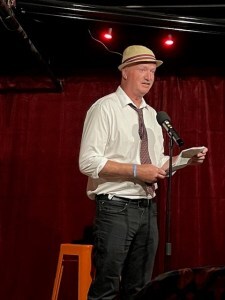
Reading at the bar
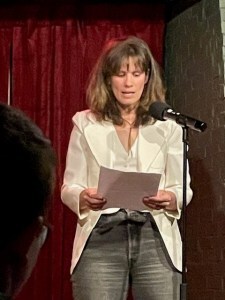
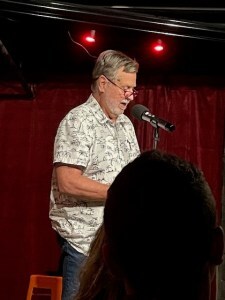

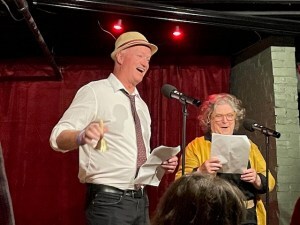
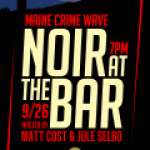

The gang at Noir at the Bar after reading
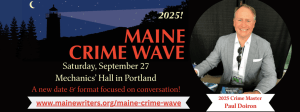
Saturday began with icebreaking exercises involving confession to an issue with a WIP and then asking strangers for advice. There’s probably a novel in that somewhere. It was followed by round table discussions, a wonderful interview of award winner Paul Doiron by Julia Spencer Fleming, more round tables, and an utterly crazy group panel to close out the days.
It would be fun to interview the participants today and see what their takeaways were and whether they left with some new ideas for their writing, so fixes for stuck spots, and just an enduring sense that in the crime writing community, we truly are there for each other.
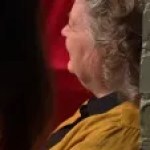
Jule and Matt waiting to ring the gong and send us off the stage
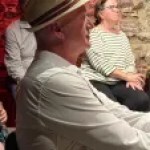

Maureen Milliken with Julia in the background

Matt Cost, looking like he suspects someone is behind him
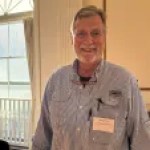
Dick Cass, dragged away from book signing to his picture taken

Rob Kelley, eagerly awaiting the debut of Raven next month

MCW alum and conference GOH Paul Doiron with Jule Selbo
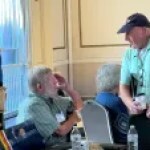
John Clark and Joe Souza catching up
September 26, 2025
Weekend Update: September 27-28, 2025
 Next week at Maine Crime Writers there will be posts by KaitlynDunnett/Kathy Lynn Emerson (Thursday) and Kate Flora (Friday). Monday will be our Post Crime Wave Report and Tuesday we’ll have a group post.
Next week at Maine Crime Writers there will be posts by KaitlynDunnett/Kathy Lynn Emerson (Thursday) and Kate Flora (Friday). Monday will be our Post Crime Wave Report and Tuesday we’ll have a group post.
In the news department, here’s what’s happening with some of us who blog regularly at Maine Crime Writers:
Matt Cost will be attending CRIME WAVE today along with a plethora of Maine Crime Writers today at Mechanics Hall in Portland. He will be leading a workshop on The Six Hats of a Writer, moderating a panel on historical mysteries with Jule Selbo, and participating on a panel of zany crime writers to conclude the day.
An invitation to readers of this blog: Do you have news relating to Maine, Crime, or Writing? We’d love to hear from you. Just comment below to share.
And a reminder: If your library, school, or organization is looking for a speaker, we are often available to talk about the writing process, research, where we get our ideas, and other mysteries of the business, along with the very popular “Making a Mystery” with audience participation, and “Casting Call: How We Staff Our Mysteries.” We also do programs on Zoom. Contact Kate Flora
September 25, 2025
Connection and Conversation
It’s been a busy summer and I’ve been looking forward to the respite the fall gives us, a chance to relax, pick up on a couple neglected writing projects and generally breathe little easier. I did do more events this summer than I have been doing and, as always, I’m struck by the randomness of success. I guess the question is how to define success. I used to think an event was measured by the number of books I sold, but I’ve come to realize that what I value the most is the interactions with people, even those who don’t buy books.
In deep summer, I attended the Belgrade Book Bash, which was created and managed by our own Maureen Milliken. We had enormous crowds, dozens of writers, but more than the (not inconsiderable) book sales, I had many of the conversations that I value: not so much salesmanship and connections as exchanges of ideas and beliefs. Over books, over reading, over Maine and the glory of summer.
which was created and managed by our own Maureen Milliken. We had enormous crowds, dozens of writers, but more than the (not inconsiderable) book sales, I had many of the conversations that I value: not so much salesmanship and connections as exchanges of ideas and beliefs. Over books, over reading, over Maine and the glory of summer.
I’m feeling like more people seek that sort of connection these days. More than buying or selling, it feels like people want to communicate, to talk, to be listened to. Even in a busy chaotic event like the book festival, it’s satisfying to be able to make connections with readers.
 Had a unique experience at Sherman’s in Damariscotta this month, where I met the first real live person who reads the Maine Crime Writer’s blog. (Shoutout to Dorrit!) I know you’re all out there, but we rarely connect in person. I’d value it if we could.
Had a unique experience at Sherman’s in Damariscotta this month, where I met the first real live person who reads the Maine Crime Writer’s blog. (Shoutout to Dorrit!) I know you’re all out there, but we rarely connect in person. I’d value it if we could.
We are, all of us, independent, because that is what we tell ourselves we need to be to survive. We learned early to rely on ourselves and have been telling ourselves how important that is ever since. But connecting with each other, over books, over coffee, over ice cream, is the way we enrich those independent lives. We don’t like to admit it, perhaps, but we do need other people.
Talking Shop—Who’s your victim?
“Everybody, sooner or later, sits down to a banquet of consequences.” Robert Louis Stevenson
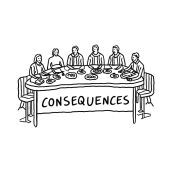 I write murder mysteries. Although they don’t all start out that way, and sometimes aren’t meant to be about murder at all. The story may begin with something that I want to explore. Human smuggling, corruption, drug dealing, greed and its ever-faithful counterpart, envy. Then, before you know it, the dead guy shows up. Since I don’t write international thrillers, my victims are everyday folks. That brings up a problem. How does a writer decide who needs killin’?
I write murder mysteries. Although they don’t all start out that way, and sometimes aren’t meant to be about murder at all. The story may begin with something that I want to explore. Human smuggling, corruption, drug dealing, greed and its ever-faithful counterpart, envy. Then, before you know it, the dead guy shows up. Since I don’t write international thrillers, my victims are everyday folks. That brings up a problem. How does a writer decide who needs killin’?
The process differs for every writer. Some find someone they really, really, really don’t like. Then they gleefully kill them off. I’ve been trying to do that to someone for a while now. The problem is, I’m still angry, and haven’t devised anything evil enough…yet. Other authors select an evildoer they’ve read or heard about and let their imagination take over. You have to admit, there’s a lot of grist for that mill. Stream-of-consciousness writers (a/k/a pantsers) just start the book and wait to see who dies. It’s as good a way as any other.
My way is a little different. One of my college majors was psychology. The study fascinated me, especially the part that dealt with how we are the masters of our destiny and authors of our downfall. The concept is like catnip to my creative mind. It’s not about blaming the victim, but about finding the moment(s) in the victim’s life that set his fate in motion. Stevenson knew his stuff.
Before I begin a book, I know three things. The victim, the protagonist, and the crime. The first mystery to be solved is why the victim died. What dreadful or unlucky event brought him to his seat at the banquet of his consequences? To discover that, I write a profile and slip on the victim’s life like a second skin. My notes delve into his childhood, education, employment, and business associates. I learn what he does for fun, and why. His personality, politics, core beliefs, and sensibilities come into play. What does he value, and why? Somewhere in this free-form writing, a behavioral pattern becomes obvious that sets the victim apart from the other characters. It’s this pattern and the victim’s reactions and rationalizations that tell me why he needs killin’. Now all that’s left is to find the right person for the job.
Writers: What’s your process? Readers: Do you read with an eye to why someone had to die? Do you feel cheated if you can’t identify an underlying cause?
(The pronoun ‘he’ is a convenience of convention, not a definitive identifier. I’ve killed women too.)
Lea Wait's Blog
- Lea Wait's profile
- 507 followers



